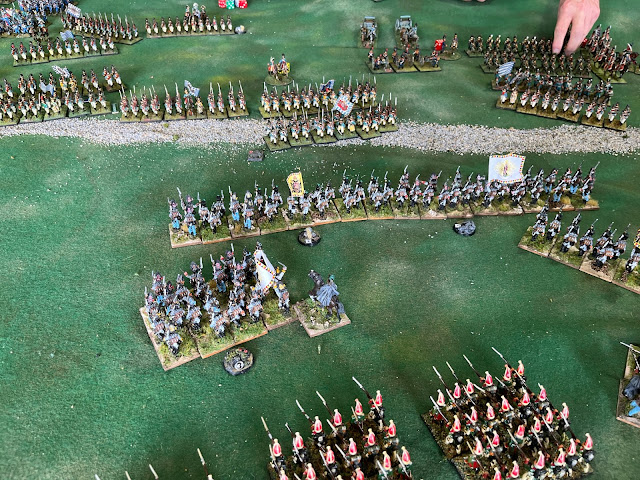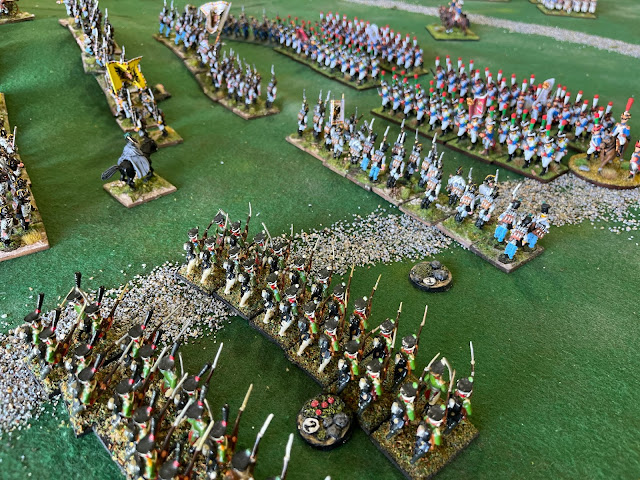This regiment is the third unit in the Prussian cavalry expansion.
I found it difficult to find much in the way of history of this unit, but its roots seem to go back to 1717 when it was formed as the 5th dragoon regiment. As dragoons it fought in the campaigns of the Revolutionary Wars, but did not participate in the disaster of 1806.
Converted to cuirassiers in the reformation of 1808 it fought in the War of Liberation, engaged at Leipzig in the cavalry Reserve of 2nd Corps. It did not fight at Ligny or Wavre in the Hundred Days Campaign. It went on to fight in the Austro-Prussian, Franco-Prussian and Great Wars.
As with other units in this Prussian/Russian cavalry expansion it was chosen on the basis of its light blue facings, although the poppy red facing of the Brandenburg Regiment were equally tempting (and may yet prove to be too tempting, forcing the expansion to two cuirassier regiments). It did seem a little odd though painting a cuirassier regiment without cuirasses. The only other Prussians planned in this expansion are a regiment of dragoons (painted but not based) and two small units of mounted volunteer cavalry that are still on their way from Nottingham.
Sunday saw us play an all-out Napoleonic scrap. Keith had provided a better description on his blog here than I could. Nonetheless here are a few images from my viewfinder.





















The light blue facings were a good choice for your dragoons. Excellent battle photos too. I notice some Front Rank Poles both foot and horse in the collections. I love those figures.
ReplyDeleteThanks Jonathan. The Poles were on the table for the first time, I think.
DeleteVery nice work on the Prussians as usual Mark. Did they actually have cuirasses or were they cuirassiers in name only? The Sunday game looks great, but after reading Keith's account just reinforces my opinion of Austrians being hard to handle. I think I'd even rather play Napoleonic Spanish.
ReplyDeleteThey were Cuirassiers in name, but were mounted on the biggest horses and carried the heavy cavalry sabre. They were presented with captured French cuirasses after Waterloo. The poor Austrians (and Russians) would have done a lot better if the French hadn’t had two or three times the number of guns than above the historical norm!
DeleteThanks for the plug, Mark, love your work! In the previous Napoleonic game, when I was French, I had two standard sized batteries and the Russians opposite had 4 or 5 large batteries - I never seem to be on the right side of the artillery equation! I do like your cuirass-less cuirassiers - it's the kind of trick one might expect from the British Army (although we just disdained cuirassiers as a cavalry type in the 19th century entirely - leave those to Johnny Foreigner, what?!) Ironically, in the 21st century, we now have the Lifeguards and Blues and Royals, both wearing cuirasses on ceremonial occasions - the logic escapes me entirely!
ReplyDeleteTypically the Russians should have two or three 12 gun batteries to the division, although in 1813 two was more common and sometimes the artillery stripped away and placed under the corps command. As for the cuirasses, knowing the British military of the 19th century I suspect that they were deemed far too expensive.
DeleteGreat job on your Cuirassiers, the facing color's a happy choice. The shots of the game show off some wonderful painted castings. I particularly enjoyed the mix of close up and long shots. Thanks again for sharing.
ReplyDeleteThanks Joe. I had planned to have a few more close ups but got too involved in the game and forgot to take them.
DeleteLovely looking heavies Mark.
ReplyDeleteYour Russo-Prussian force is certainly going to pack some punch.
All the best. Aly
Thanks Aly. I certainly hope it will!
DeleteLovely looking cuirass less cuirassiers and a great looking battle!
ReplyDeleteBest Iain
Thanks Iain. I do like these guys.
Delete